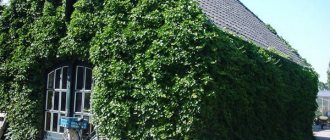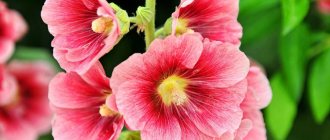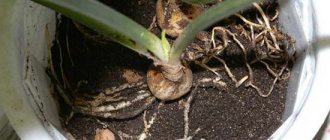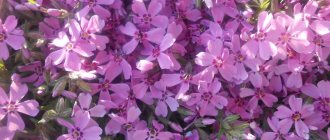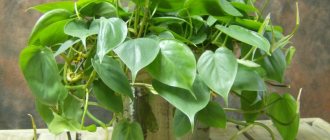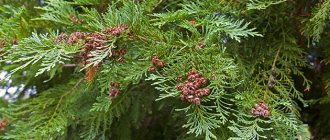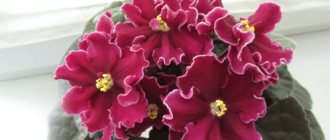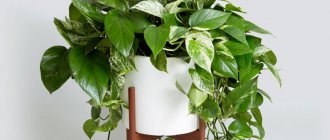General characteristics of fatsia
This is a woody plant with large leaves. Their width can sometimes reach 40 cm. The fatsia leaf is very original and beautiful due to its shape in the form of an open five, and has a glossy, bright green color. The height of this representative of the flora in natural conditions is about 4 meters. Indoor flowers require a lot of free space, free arrangement, and only if these conditions are met can they delight you with a chic crown.
The plant belongs to the Araliaceae family and has a single pure species called Japanese fatsia, as well as several varieties (see their names and photos at the end of the article).
Mr. Summer Resident recommends: Fatsia is a tonic plant
The beneficial properties of fatsia lie in the large amount of essential oils and chemicals in the leaves.
In medicine, the shrub is used as an invigorating remedy to improve immunity. To prevent diabetes mellitus, medicines are prepared from fatsia root.
Harmful properties include toxicity. The juice of the leaves contains toxic substances that can cause irritation, itching and redness of the skin; especially sensitive people may experience local allergies; working with the plant requires gloves.
Fatsia is a hardy and unpretentious culture. Even an inexperienced gardener can grow a strong and strong plant that will delight the eyes of the household.
Lighting and location
- The green pet loves bright, (not sunny), cool places with a regular supply of fresh air. The place should be slightly shaded, with diffused light;
- An excellent location for the bush is the western or eastern side of the house;
- The variegated Japanese beauty needs sun, and varieties with leaves of the same shade stand well in the shade;
- In summer, an indoor flower can be placed outside, avoiding direct sunlight.
Humidity and watering
- In hot weather, the bush should be watered generously with clean, cool water. By autumn, the amount of water decreases;
- In winter, the “green resident” is watered less often and kept cool;
- When several hours have passed after moistening the soil, remove excess liquid from the pan, otherwise the roots of the bush will rot;
- If the soil dries out, the "southerner" may drop its leaves, and it will be extremely difficult to raise them again. For this purpose, special spacers are made and the leaves are tied horizontally;
- Caring for Fatsia at home involves maintaining high air humidity in your home. Spray the leaves with a spray bottle, if possible, carry out wet cleaning daily, wipe the leaves with a napkin.
PS We wrote about how to humidify the air in a room here.
Problems with growing aralia
If the conditions of care and maintenance at home are violated (for example, air humidity decreases or it increases at low heat levels), then the plant is affected by red spider mites, whiteflies, aphids, thrips, and scale insects. These pests are visible on both sides of the leaf blades in the form of brown or whitish dots (insect eggs), or piercing the edges of the leaf, like a pin. The plant begins to sharply lose its decorative appeal, its growth slows down, the leaf blades turn yellow, become deformed, curl and fall off prematurely. It is necessary to regularly inspect fatsia, and if pests are found, you need to manually remove them from the leaves or branches with a cotton swab dipped in an oil, soap or alcohol solution. If gentle means help little, then treatment is carried out with a systemic insecticide (for example, Actellik or Karbafos - at the rate of 15-25 drops of the mixture per 1 liter of water). After a couple of weeks, the treatment is repeated for preventive purposes.
Sometimes a fungal disease occurs - gray rot. The cause may be high humidity with low heat levels. The stem from the very bottom begins to acquire a brown tint, then rotting occurs. And soon it is covered with a dark gray layer, sometimes with a brownish tint, of fungal deposits (spores). It is necessary to remove the affected parts of fatsia, change the conditions of maintenance and treat with a fungicide. If the degree of damage is large, then the diseased plant cannot be saved; it will die.
Problems with growing aralia include:
- overmoistening the soil will cause the leaf blades to become soft and limp;
- if the air humidity is too low, the leaves become fragile and break off easily;
- with sunburn or dry air, the leaf plate shrinks;
- if moisture is insufficient, then the tips of the leaf lobes become brown and may break off;
- if the soil has been flooded, this will lead to yellowing of the leaves and the fatsia dropping them.
Replanting and pruning indoor flowers
Caring for fatsia is not difficult, because it easily tolerates formative pruning for a more luxuriant crown. When pruning a young “southerner”, the top is pinched off. After some time, foliage will appear on the trunk, and new young shoots will appear near the base, which will later serve as cuttings for transplants.
House shrubs are replanted every few years. The new container should be larger than the old one, because the tree-like plant can please you with young trunks. Fatsia is replanted as follows: one-third of the pot is filled with broken shards and expanded clay, and soil mixture is added to the rest.
Signs and superstitions
It is believed that Fatsia is protected by the planet Mercury, and the zodiac sign influencing the plant is Libra.
This tandem gives Fatsia the ability to cleanse her home of bad energy and bad thoughts of others. If you or your household members often experience stressful situations or are depressed, Fatsia can help you cope with problems within your family by absorbing the negativity around you. This lush green flower has a positive effect not only on the psychological, but also on the physical level, having a beneficial effect on the body in a number of chronic diseases (pathologies of the liver, kidneys, adrenal glands, bladder).
Fatsia cuttings
- Propagation by cuttings is carried out in the spring. Rooting at a temperature of 24-26 degrees in moist soil with diffused light occurs very quickly;
- Cuttings 10 cm tall should acquire a certain number of buds that are ready to grow;
- Cover them with a glass jar or film, and plant them in the ground a month after rooting. With this method, voluminous but small shrubs are formed.
How to propagate Fatsia by layering
When a flower is properly cared for, its trunk is abundantly covered with foliage. If it becomes bare, the plant is rejuvenated using layering:
- In the spring season, the bark on the trunk covering must be cut;
- Wrap the incision with wet moss, which is soaked in a solution with fertilizers or a phytohormone;
- Wrap with film;
- Make sure that the moss is always damp;
- After a certain time, the first root will appear at the incision site;
- After this, after 2 months, cut off the top with roots and plant in a separate container;
- The top must be cut off slightly below the emerging roots.
When and how can I replant?
Yucca is transplanted into another pot at home as needed and as the flower grows, but not more often than once every 1-2 years. This allows:
- increase the amount of nutrients by replacing or adding soil;
- transplant into a larger pot if the old one no longer holds the yucca;
- inspect the root system for rot or disease.
The procedure is carried out in early spring, rarely in autumn.
For transplantation, the transshipment method is used, it occurs according to the following scheme:
- A pot is prepared in advance, which is 3-5 cm larger in size than the root system of the flower. A drainage layer is placed on the bottom and sprinkled with a small layer of soil.
- An hour before transplanting, water the yucca so that the soil softens and the flower can be removed without damage.
- The pot with the flower is turned on its side and carefully taken out along with a lump of earth.
They begin to water the flower only after 2-3 days, in small portions.
It is important not to apply nutritional supplements in the first month after transplantation. If damaged or diseased roots are found, they are cut off with sharp garden pruners
Then the sections are sprinkled with crushed charcoal. After this, they are transplanted into a new pot.
Replanting yucca grown in the garden is rare. Basically, this procedure is carried out to divide the bush if the bush has thickened. In one place, a flower can grow from 15 to 20 years. The time of transplantation is spring or late summer - early autumn.
On a note! The optimal age of yucca for transplantation is up to 3 years, until the root system has grown significantly, otherwise there is a danger of damaging the tubers. The length of the roots of an adult plant reaches 60-70 cm.
How to plant a garden flower:
- dig up the soil at a distance of 20-25 cm from the mother stem to reach the daughter rosettes;
- the clod of earth is not removed from the roots, but to prevent it from crumbling when transferred to another place, the shoots are placed on burlap or polyethylene;
- young shoots are transplanted into pre-prepared holes, at the bottom of which drainage, leaf compost and turf soil are laid;
- The shoot with roots is installed in the center of the hole and the remaining space is filled with the remaining soil.
The first complex feeding is applied no earlier than after 14-16 days. Water like an adult plant.
Unpretentiousness in care and undemandingness in watering have made the flower popular among gardeners.
- Plant type: Decorative.
- Flower/fruit color: Soft pink, white, purple. The seeds are black.
- Leaf color: Dark green, some varieties with white or yellow stripes.
- Need for sun: Loves the sun.
- Size: Medium and large, depends on the variety.
- Flowering: Garden flowers bloom, domestic ones - rarely. Blooms in late spring - early summer.
- Aroma: Strong, fragrant, reminiscent of expensive soap.
Propagation by seeds
Growing fatsia from seeds is a simple process:
- Place fresh seeds in the soil 10 mm deep. For these purposes, we will take small boxes;
- Soil for seeds: leaf soil, sand and turf (1:1:1);
- We maintain the temperature regime of the ground and surrounding airspace at a temperature of 18 degrees;
- After germination, seedlings are transplanted one at a time into separate pots. Soil for sprouts: turf, humus, sand (2:1:1);
- Place the pots in a bright place.
Brief description of cultivation
- Bloom . Fatsia is cultivated as an ornamental foliage plant.
- Illumination . Species with green leaves can be placed in a slightly shaded place, but variegated species need bright, indirect light.
- Temperature regime . In the spring and autumn, the air temperature should be from 17 to 21 degrees, and in winter - from 13 to 15 degrees. If the plant is variegated, then the room where it is located should not be allowed to be colder than 16 degrees.
- Watering . During intensive growth, the bush is watered immediately after the top layer of the substrate has dried. If in winter it is cool, then watering should be reduced to a minimum, but at the same time you need to ensure that the earthen lump does not dry out completely.
- Air humidity . It should be elevated. Experts advise systematically moistening the foliage with a sprayer, and also wiping it with a dampened soft cloth.
- Fertilizer . During the growing season, the plant is fed once a week with organic matter or mineral fertilizers. If the flower is cool in winter, then there is no need to feed it. And when it overwinters in a warm place, feeding is carried out no more than once every 4 weeks.
- Trimming . Conducted in spring. There are varieties of fatsia whose stems need to be shortened regularly.
- Transplant . The flower is replanted once every 3 years in spring or in the first weeks of summer.
- Soil mixture . Leaf, turf and humus soil, as well as sand and peat (1:1:1:1:1).
- Reproduction . Seed and vegetative (layering, cuttings) method.
- Harmful insects . Whiteflies, scale insects, spider mites and mealybugs.
- Diseases . If the plant is not given proper care or is placed in unsuitable conditions, it may develop foliage problems.
- Properties . All parts of such a plant contain poison.
Aralia japonica / Fatsia / Japanese houseplants
Pests and diseases of indoor fatsia
Pests that can damage a home flower: whitefly, mealybug, thrips, aphids, scale insects, spider mites.
- When they appear, treat the stem covering and leaves by spraying with fungicides - 3 times, take a break for a few minutes. The best effective way is to use the Actellik product;
- A simple soap solution, sprayed several times a day, will also help.
Ailments of the southern pet:
- Sunburn (a representative of the flora is in direct sunlight): its leaves become wrinkled. Treatment: it is necessary to increase air humidity, make shade for the shrub;
- Lack of moisture: leaves break and dry out. Treatment: abundant watering and “shower” every day in the summer;
- Excess moisture: drooping and soft foliage. How to help: do not water for several days, remove the liquid from the pan;
- Gray rot (the flower is kept in a damp, cold place): the stem rots and turns brown. Treatment: place in a more ventilated area, remove damaged parts.
Caring for Fatsia at home
Fatsia is considered an unpretentious plant. We will tell you about the rules for caring for this shrub at home, and you will see for yourself that it is not difficult.
Purchase and first steps
In the store, choose a small, still young plant that has not had time to grow much. Pay attention to its appearance - the leaves should be healthy, shiny, without visible damage and insects. If the leaves are drooping and drooping, then this is a sign that the plant is unhealthy or is poorly cared for. Returning them to a normal horizontal or elevated position will most likely be difficult or even impossible. Therefore, do not buy such a plant.
If you make a purchase in winter, then do not forget that Fatsia is originally from the tropics, do not freeze it on the way home. We advise you to wrap the pot in several layers of polyethylene in a warm room so that the resulting “bag” is filled with warm air. After arriving at the place, do not remove the film for 2-3 hours - let the flower adapt to the new conditions. Then once again carefully inspect all its leaves for the presence of pests, and at the slightest suspicion, wash them with warm soapy water. One and a half to two weeks after purchase, transplant Fatsia into a new, slightly larger pot.
We advise you not to simply transfer the flower to another pot with a lump of earth, but to completely clean the roots from the transport substrate. At the same time, check the condition of the root system and remove broken and rotten roots, if any.
Soil and pot
The plant is suitable for soil rich in nutrients. But it must be loose, light and water-permeable. A ready-made universal substrate from the store for decorative foliage plants is suitable.
You can also prepare the substrate yourself. To do this, take 2 parts of turf soil and 1 part each of leaf humus, peat and sand. Acidity should be slightly acidic or normal (pH from 5.0 to 7.0).
Choose a clay or ceramic pot, which is more stable for a large plant, with drainage holes in the bottom. For a young flower, the pot should be deep, but not very wide, 2–3 cm wider than the root system. At the bottom of the pot there should be a layer of drainage made of large pieces of expanded clay, brick or pebbles, occupying 1/3 of the height of the pot.
Support
In the wild, Fatsia grows without support. But at home he often needs support. The trunk of the plant is quite thin and is not always able to support a massive crown. You will have to take care of support in advance before the flower bends to one side. Then it will be difficult to correct the situation. Fatsia's shoots are not so elastic, and if you notice that the stem begins to deviate from the vertical, take immediate action. The support for the flower can be bamboo sticks or posts wrapped in coconut fiber. You can buy them in flower shops or make them yourself. The main thing is that this support is stable and does not interfere with the growth of leaves.
Fatsia transplant
Since the plant develops and grows quite quickly, especially at a young age, it should be transplanted annually, in the spring, into a new, slightly larger pot. Adult specimens need to be replanted less frequently, once every two to three years, and then only on the condition that its roots have begun to peek out of the drainage holes. In the intervals between transplants, we advise you to simply replace the top layer of soil in the pot with fresh substrate in the spring. Choose a pot 3–5 cm wider and deeper than the old one. Transplantation is carried out by transferring the plant along with a lump of earth into a new pot, prepared according to all the rules. Then carefully remove the top part of the soil, and pour new substrate in its place and in all free spaces on the sides of the pot. Then water.
If you are transplanting a diseased flower in order to remove rotten roots, then the soil from the roots should be carefully shaken off, rotten, dry or broken roots should be cut off. Sprinkle the cut areas with crushed coal. Only then can the plant be placed in a new pot and covered with fresh substrate.
Top dressing
From early spring to October, during the period of active growth of Fatsia, it needs to be regularly fed with fertilizers with a high nitrogen content. Complex fertilizers for decorative foliage plants in liquid form are suitable. Apply one dose of fertilizer during or after regular watering every 10-12 days. In winter, Fatsia should not be fed, even if the plant is in an active state and winters in a warm room.
Lighting
As we wrote earlier, the indoor flower Fatsia is able to adapt to any lighting. It can even grow with great success under artificial light. Just try to keep the lighting more or less stable throughout the year. Then, having adapted to a certain lighting intensity, the flower will grow and develop normally. This gives it a significant advantage among similar indoor plants. It will grow quickly in any location and retain the attractive shiny color of its leaves.
Variegated forms and Fatsia varieties need stronger lighting. The bright sun will not burn Fatsia's dense leaves, but extreme heat can cause them to become lethargic. It is better to stick to diffused lighting or openwork partial shade.
But we recommend placing adult plants of impressive size in the shade - their attractiveness will remain, but growth will noticeably slow down
Temperature
Fatsia does not have any special requirements for ambient temperature. It is suitable for a wide range of temperatures, from 18 to 25 degrees. Higher temperatures will not harm the flower if it is shaded from direct sunlight and properly watered. But it will be better if the ambient temperature is moderate, then the flower will look gorgeous.
In winter, if you send a flower to forced rest, the temperature can be reduced to 15 degrees. heat (variegated varieties up to 18 degrees). But hibernation is not vital for a flower; some gardeners just don’t want the extra hassle of providing the flower with additional lighting. When wintering under normal indoor conditions, Fatsia will have to be placed closer to the south window and turn on a fluorescent lamp or phytolamp in the evening for two to four hours after it gets dark outside the window.
Fatsia loves fresh air and is not at all afraid of drafts in the summer. Therefore, you can take it out to the balcony or veranda all summer long with shelter from precipitation and direct sunlight.
Watering
The watering regime for Fatsia japonica is the most important point in the rules for caring for the plant. The flower loves abundant watering and moist soil. If you do not water its substrate in time and discover this when its leaves droop and droop, most likely, abundant watering may not bring them back to life. At the very least, you will have to install a support for its drooping leaves in order to somehow give them a horizontal position.
However, the flower also reacts negatively to excessive watering - the shoots will begin to turn yellow, the leaves will become soft and fall off, and the roots will rot. This is why it is so important to keep soil moisture stable.
In the spring-summer period of the year, water when the top layer of soil dries a couple of cm deep. In autumn, gradually reduce the volume of water, but it is strictly forbidden to allow the earthen clod to dry out completely.
This may be interesting: Aglaonema - home care
Water the flower only with settled water at room temperature until water appears from the drainage holes of the pot. After some time, be sure to remove excess water from the pan.
If the flower is not sent to rest in a cooler room in winter, then each subsequent watering should be only after the soil in the pot has dried almost half. Water generously until water appears in the pan. Drain off excess water. If the room is cool, then it is better to slightly warm up the water for irrigation.
Humidity and spraying
Fatsia has rather large leaves that actively evaporate moisture. Therefore, the flower does not like too dry air. The humidity in the room should be normal or slightly higher. Otherwise, the tips of the leaves may dry out, which will spoil the appearance of the flower. It is not necessary to install air humidifiers or place the pot in a tray with wet expanded clay. Regular ventilation of the room and regular spraying of the surrounding air and leaves are sufficient.
Fatsia likes her leaves to be sprayed daily with soft water at room temperature. Even in winter, if the room is hot, spray the flower at least a couple of times a week. But you should not spray in a cool room.
Bathing
In the hot summer, the flower loves to take a shower. Place the pot in the bathroom, cover the soil with film. Wash the leaves well with cool shower water.
The rest of the time, dust from Fatsia leaves should be removed using a damp cloth, soft cloth or sponge. The cleanliness of the leaves not only gives beauty to its crown, but also provides the plant with breathing and nutrition, and prevents the appearance of parasitic insects.
Crown formation
Fatsia is reluctant to branch on its own, and if left undisturbed, it will grow in the form of a stem with long petioles and large leaves. Over time, the lower ones will inevitably age and die, and the trunk will become bare. You will get a crown on top, like a palm tree. But if you regularly carry out the formation by pinching the tops of the shoots, the lateral buds will begin to develop. They will give new branches, and Fatsia will become a fluffy bush. Pinch back the tops throughout the year. On the eve of spring awakening, perform sanitary pruning, remove weak shoots that have lost their decorative appearance. The flower tolerates this procedure well. Just do it better in the morning so that the sap flow stops in the evening.
Fatsia flowering
Fatsia is grown as an ornamental foliage plant, although it can bloom indoors. Some flower growers believe that its flowering is completely unremarkable, that it only weakens the strength of the flower and spoils its attractive appearance. But others consider Fatsia's flowering to be original.
Fatsia begins to bloom somewhere in mid-autumn, when other indoor plants are already preparing for winter. A complex umbrella inflorescence grows in the center of the bush. It grows up to 30 cm in diameter and consists of smaller, ball-like, white or greenish-cream inflorescences in the form of umbrellas, up to four cm in diameter. Small bisexual flowers consist of an ovary and 5 long stamens. The petals are weakly defined and look like a short wavy border around the core. Against the background of large shiny foliage, the flowers seem airy, lacy, a little like dandelion flowers.
Fatsia berries
After pollination, a fruit is formed in the lower ovary in the form of a small round drupe, half a cm in diameter. These berries, black or dark purple in color, are similar to rowan berries. So the fruits of Fatsia look no less decorative than the leaves. Seeds, however, do not always ripen in them and quickly lose their viability.
Types of fatsia
- Fatsia Lizei (Lizei) - grows in the form of a bush, the leaves cover the stems in a thick layer. The leafy, leathery plate is divided into 4-5 “blades” of a dark emerald hue. The “green resident” is winding and needs support;
- Fatsia Samurai - very similar to Japonica, has leaf plates 30 cm in diameter, in the shape of “lobes-blades” with a glossy surface. The height barely reaches 1.5 meters. It blooms with fragrant, fragrant flowers that have a whitish or greenish tint. The flowers are “umbrellas”, and the fruits are small dark blue berries;
- Fatsia imperia has overly large, shiny glossy leaves that form a dense crown of a tree in the shape of a ball with a diameter of up to 40 cm. The height is measured at 1.5 meters and it blooms rarely;
- Fatsia japonica is another name for the Aralia fatsia flower. It has the shape of a tree with a slightly branched trunk and light brownish bark. The shape of the leaves is round, divided into “lobes - fingers”; parts of the leaves have a serrated edge and a broadly lanceolate shape.
In floriculture, the most popular garden forms of Fatsia japonica are:
- Miseri is a small compact plant with rich green leaves;
- Aureimarginalis – the veins on the leaves have a yellowish tint;
- Fatsia variegata (Variegata) - the edges of the leaf blades of this shrub are painted milky or white.
You can buy fatsia in online flower shops. Its price depends on the height of the specimen and the diameter of the pot. For example, the cost of a plant 50 cm high in a pot with a diameter of 17 cm will be approximately 750 rubles.
Transfer
Young Fatsia specimens need to be replanted every spring, while adults need to be replanted once every two or three years. It is important to remember that this plant needs good drainage from expanded clay - it should occupy at least a third of the pot. Fatsia can also be grown quite successfully hydroponically.
Soil for replanting fatsia can be bought in a store or made independently from the following components:
- 2 parts of turf land;
- 1 part humus soil;
- 1 part peat;
- 1 part coarse sand.
